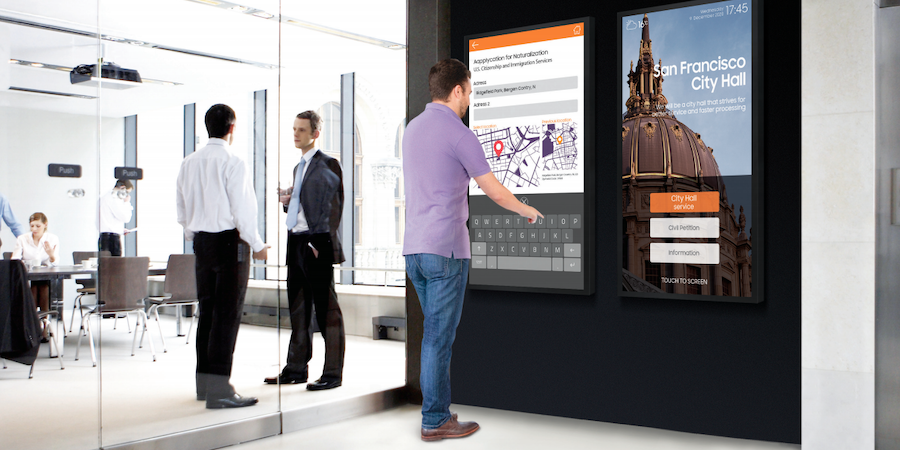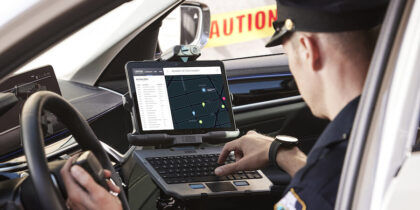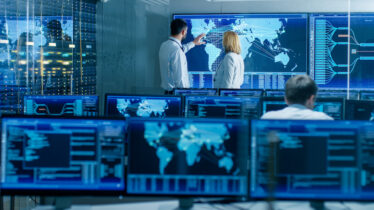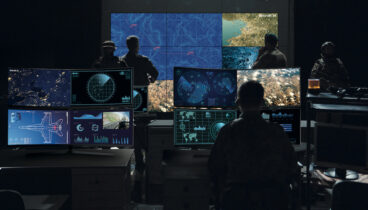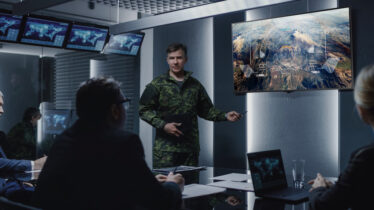Many federal employees are still working from home, and experts say the trend will continue, probably in a hybrid form that rotates work at home with work at the office.
Gartner predicts that by 2024, meetings will drop from 60 percent in person to 25 percent in person. Almost 50 percent of state and local government respondents say their agencies will support a hybrid work model for at least the next two years. Even the White House noted in a June 2021 memo that federal agencies can offer their employees more flexible schedules and remote work.
Now that hybrid work is common, and likely to stick around for the next several years, government agencies are rethinking how they handle team collaboration. Interactive whiteboards like Samsung’s 85-inch Interactive Display can help everyone stay in the loop, maintain strategic relationships and share their knowledge, ideas and skills.
Creating the conference room of the future
Typical meeting rooms and conference rooms feature one large table with a speakerphone in the middle, surrounded by chairs. They may also have a dry-erase board and/or a projector or TV that can be connected to a computer. This setup featuring legacy conferencing technology works pretty well when everyone is physically present, but it’s less conducive to collaboration when some participants are remote.
Secure your federal display technology
Get your free guide to the cybersecurity essentials for large-format displays in government agencies. Download Now
To maintain productivity and effective collaboration, government agencies need modern meeting rooms complete with digital multitasking technology. Unlike conventional dry-erase boards, interactive whiteboards are internet-enabled and allow participants to connect, share and edit documents — zooming in and out as needed, and pasting pages or files onto the whiteboard for reference. Most importantly, these government collaboration tools allow people in multiple locations to use these features to collaborate remotely. Important content and conversations are automatically saved and stored digitally, in real time.
The need for ‘anytime’ collaboration
Samsung’s Interactive Display supports up to 20 touch points, allowing several people to interact with the screen simultaneously. The board’s embedded browser and screen mirroring capability make it highly versatile. And as people write, edit and draw on the board, multiple connectivity options allow users to quickly share on-screen content. This functionality makes it much easier for remote workers to fully participate, since they can access the same collaboration features as those physically in the room.
For situations that require more computing power or interactivity, a digital whiteboard such as the Interactive Pro can connect to a PC, essentially making the board an extension of the PC. Attendees can see the PC’s desktop displayed on the whiteboard, and on-site participants can control the PC directly from the whiteboard screen.
Integrating interactive whiteboards with existing tech
As you consider upgrading your agency’s collaboration technology, make sure that whatever you add integrates smoothly with the technology that your team currently uses. If your new interactive whiteboard can sync with users’ personal devices, for instance, meeting attendees can control the device from their smartphones and share content in real time. For full integration, any changes made on the interactive whiteboard can be reflected on the connected device, and vice versa.
For government agencies, Microsoft Teams integration is critical, since the vast majority of agencies — federal, state and local — have standardized on the Microsoft productivity suite. One of the simplest ways to accomplish this is through the whiteboard’s web app. This allows Teams users to write, draw and collaborate on the board effortlessly.
New collaboration realities
Aside from internal collaboration between remote and in-person team members, interactive whiteboards also make it easier for your team to collaborate with other agencies. Interagency digital collaboration has taken off — starting as a pilot program through the Federal CIO Council, and continuing with a new U.S. General Services Administration program management office.
Brainstorming, delegating, questioning, debating and decision making are all critical parts of successful collaboration. Much of this process used to take place behind closed doors, but in the wake of cultural changes and cutting-edge technologies, professional collaboration is more open than ever. Government collaboration technologies like interactive whiteboards unite every step of the process, so every team member, near and far, can work together.
Learn more about creating secure, flexible and data-driven work environments for remote and in-person collaboration in government agencies in this free comprehensive guide. And explore more of Samsung’s interactive displays, designed for versatile and easy collaboration from anywhere.

